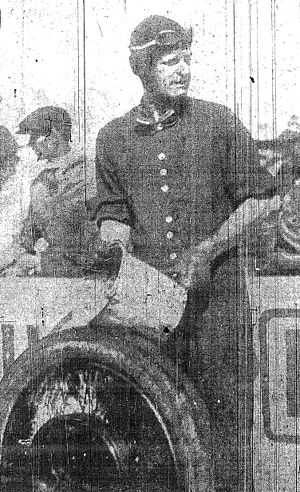Johnny Aitken
| Johnny Aitken | |
|---|---|
 | |
| Nationality |
|
| Born |
May 3, 1885 Indianapolis, Indiana, United States |
| Died | October 15, 1918 (aged 33) |
| American Automobile Association | |
| Years active | 1907-1916 |
Johnny Aitken (May 3, 1885 – October 15, 1918) was a racecar driver from Indianapolis, who was active in the years prior to World War I.
Aitken competed in the Indianapolis 500 three times. He started the race twice, in 1911 and 1916. He led the first lap of the first race (1911). Aitken captured the pole position in 1916, but ended up in 15th place (his best finish) that year. In the 1915 Indianapolis 500, Aitken drove relief for two drivers, Gil Anderson and Earl Cooper (who ultimately finished 3rd and 4th).
While Aitken never won the Indianapolis 500 as a driver, he did serve as team manager for two winning efforts, Joe Dawson’s victory in 1912, and Jules Goux’s win in 1913.
Aitken’s activity at the Indianapolis Motor Speedway was not limited to the Indianapolis 500. He won a total of 15 races at IMS, the most of any driver in the 100-year history of the track. Aitken was the only driver to win races in each of the four automobile race weekends that were held during the track’s “pre-500” years of 1909-1910. He also won all three races which comprised the Harvest Auto Racing Classic, in September 1916. (The driver with the second-greatest number of wins at IMS is Ray Harroun, with 8 wins in 1909-1911.)
Aitken started a total of 41 races at the Indianapolis Motor Speedway, which is, again, the most of any driver in the track’s history. (The driver with the second-greatest number of starts at IMS is A. J. Foyt, who started a total of 36 races from 1958 to 1994.)
Outside of his participation at the Indianapolis Motor Speedway, Aitken is known to have started at least 33 AAA-sanctioned races, from 1907 to 1916, and to have driven relief in at least three others. He won seven of these races, including the 1916 1st International Sweepstakes race (300 miles, Sept 14, at the Cincinnati Motor Speedway), the 1916 Astor Cup Race (250 miles, Sept 30, at the Sheepshead Bay Speedway), and the 1916 Harkness Trophy Race (100 miles, Oct 28, also at Sheepshead Bay).
Aitken is credited as co-winner of the American Grand Prize race, which was held at the Santa Monica Road Race Course on Nov 18, 1916. He started the race, but was the first driver to drop out, when his car suffered a broken piston after one lap. On Lap 21, he took over the car which had started the race being driven by Howdy Wilcox. Aitken drove that car for the remainder of the race, completing 28 of the total 48 laps, finishing first. Aitken, therefore, was credited with both first and last place, which would not be permitted under today's rules. In modern motorsport, except in sportscar races where multiple drivers are used, a driver is only credited with participation, and points, from the car that he started the race; if he drops out and then is a relief driver for another driver in another race but wins the race, only the driver who took the start will be credited with the win.
Aitken died of bronchial pneumonia, brought on by the Influenza Pandemic of 1918 (also known as the Spanish Flu).
Indianapolis 500 results

|
| ||||||||||||||||||||||||||||||||||||||||||||||||||
References
- Scott, D. Bruce; INDY: Racing Before the 500; Indiana Reflections; 2005; ISBN 0-9766149-0-1.
- Galpin, Darren; A Record of Motorsport Racing Before World War I.
- http://www.motorsport.com/stats
- http://www.champcarstats.com
- Dill, Mark; "A Forgotten Classic;" 2006 Allstate 400 at the Brickyard Official Program; Indianapolis Motor Speedway.
External links
- Johnny Aitken driver statistics at Racing Reference